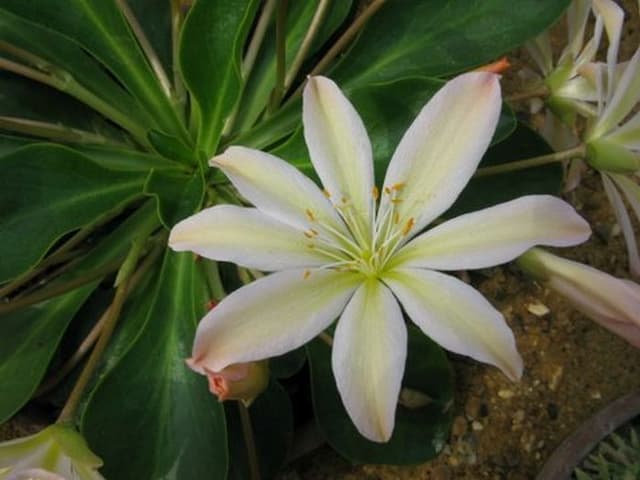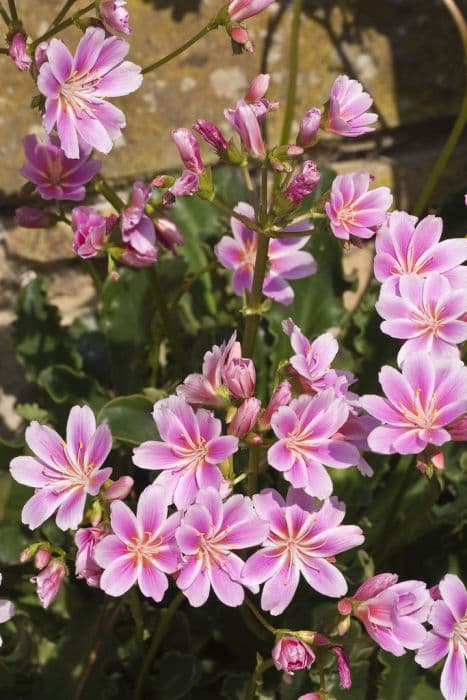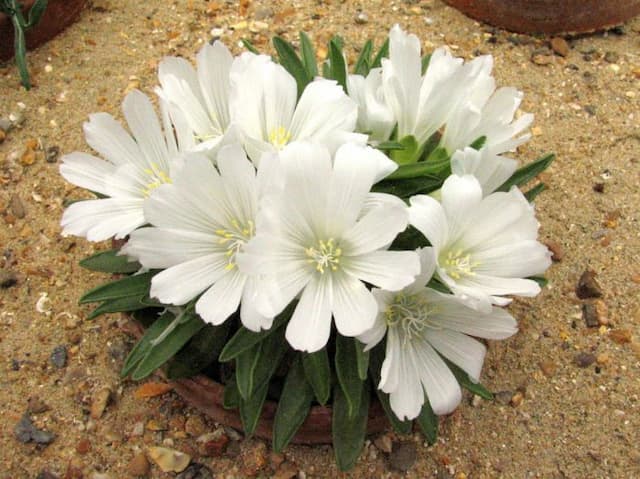Siberian springbeauty Claytonia sibirica

ABOUT
The plant in question, commonly known as Siberian spring beauty, is a charming and delicate perennial that brightens up woodland gardens and shaded areas. The foliage of this plant typically consists of pairs of smooth, succulent-like leaves that are broadly oval-shaped with a rounded or slightly pointed tip, each pair clasping gracefully at the base of the flowering stems. The leaves are fresh green, offering a vibrant backdrop for the flowers. The blossoms emerge in clusters atop slender, upright stems, radiating an enchanting appeal. Each flower typically features five rounded petals that can best be described as white to a soft pink hue, often with delicate pink veins that can give the petals a striped appearance. Towards the center, the petals surround a delicate array of stamens which are often yellow or pinkish in color, providing a striking contrast against the petals. The charm of the Siberian spring beauty not only lies in its appealing foliage and attractive blossoms but also in its ability to add a splash of color to the early season landscape, often being one of the first plants to bloom as winter recedes. Despite the omission of its physical dimensions, this description aims to create a vivid image of the plant's artful presence.
About this plant
 Names
NamesSynonyms
Siberian Springbeauty, Candy Flower, Siberian Miner's Lettuce, Pink Purslane.
Common names
Claytonia alsinoides, Montia sibirica, Limnia sibirica.
 Toxicity
ToxicityTo humans
Candyflower, the common name of Claytonia sibirica, is generally considered to be non-toxic to humans. It is often consumed as a wild edible, particularly its leaves and stems, which are used in salads and other dishes. There are no commonly reported symptoms of poisoning from Candyflower, as it is not recognized as a poisonous plant.
To pets
Candyflower, which is Claytonia sibirica, is also considered to be non-toxic to pets. It is not commonly known to pose any serious risk if ingested by animals such as dogs or cats. As with human consumption, there are no well-documented cases of poisoning or harmful effects from pets ingesting this plant.
 Characteristics
CharacteristicsLife cycle
Perennials
Foliage type
Deciduous
Color of leaves
Green
Flower color
Pink
Height
0.5 feet (15 cm)
Spread
0.5 feet (15 cm)
Plant type
Herb
Hardiness zones
Varies
Native area
Siberia
Benefits
 General Benefits
General Benefits- Edible Parts: Claytonia sibirica, commonly known as Siberian spring beauty or candy flower, has edible leaves and flowers that can be consumed in salads or cooked as greens.
- Nutrition: The plant provides a source of vitamins and minerals when eaten, contributing to a balanced diet.
- Culinary Use: The mild flavor of Siberian spring beauty makes it a versatile ingredient for culinary purposes, adding a unique element to dishes.
- Ornamental Value: This plant is often appreciated for its delicate flowers and can be used to beautify gardens spaces.
- Low Maintenance: Siberian spring beauty is known for being hardy and requiring minimal care, making it suitable for novice gardeners.
- Early Blooming: It is one of the first plants to bloom in spring, helping to revitalize gardens after winter and provide early nectar for pollinators.
- Wildlife Support: The flowers attract bees, butterflies, and other pollinators, supporting local ecosystems and biodiversity.
- Cold Tolerance: The plant is tolerant of cold temperatures, allowing it to thrive in cooler climates and extend the growing season.
- Ground Cover: It can serve as a natural ground cover, reducing weed growth and soil erosion with its foliage.
- Naturalization: Claytonia sibirica can naturalize in suitable environments, spreading to create a more robust plant presence without the need for replanting.
 Medical Properties
Medical Properties- Claytonia sibirica, commonly known as "Siberian spring beauty," has traditionally been used by indigenous peoples as a source of vitamin C to prevent scurvy.
- The plant has been recognized for its potential anti-inflammatory properties, although this use is largely based on traditional knowledge rather than scientific studies.
- There is some ethnobotanical reference to its use as a demulcent, soothing irritated or inflamed skin or mucous membranes.
- It has been used in folk medicine as a diuretic, although clinical evidence supporting this use is limited.
 Air-purifying Qualities
Air-purifying QualitiesThis plant is not specifically known for air purifying qualities.
 Other Uses
Other Uses- As a natural dye: The leaves, stems, and flowers of Pink Purslane can be boiled to extract a pigment for use in dyeing fabric or paper.
- In companion planting: Gardeners may plant Pink Purslane alongside other vegetables as a ground cover to help retain soil moisture and suppress weeds.
- In floral arrangements: The delicate flowers and foliage of Pink Purslane can be used as a filler in floral arrangements for their subtle beauty.
- As a food colorant: The natural pigments in Pink Purslane flowers could potentially be used as a non-toxic food coloring in culinary presentations.
- In educational settings: Pink Purslane can be used in schools or educational programs to teach children about wild edible plants and botany.
- For habitat restoration: Pink Purslane may be used in native plant gardens or restoration projects to help support local ecosystems and biodiversity.
- As a survival food: In a wilderness survival scenario, Pink Purslane, being an edible plant, can be a foraged food source.
- In crafting: The stems and flowers of Pink Purslane can be incorporated into homemade paper or wreaths for their texture and color.
- As living mulch: In permaculture, Pink Purslane can be used as living mulch to protect soil health and fertility.
- For photography and art: The plant's vibrant and delicate flowers can be a subject for photographers and artists to capture in various media.
Interesting Facts
 Feng Shui
Feng ShuiThe Siberian miner's lettuce is not used in Feng Shui practice.
 Zodiac Sign Compitability
Zodiac Sign CompitabilityThe Siberian miner's lettuce is not used in astrology practice.
 Plant Symbolism
Plant Symbolism- Persistence: The plant's ability to survive in cold climates and its resilience to challenging conditions symbolize the human qualities of persistence and endurance.
- Innocence: The delicate and small flowers of Claytonia sibirica, commonly known as Siberian Spring Beauty, can represent purity and the simple pleasures of life, just as the plant brightens its environment with its unassuming beauty.
- Youthful Joy: Siberian Spring Beauty often emerges in early spring, symbolizing new beginnings, youthfulness, and the joy that accompanies the start of a new cycle in nature.
- Adaptability: Its capacity to adapt to various environments symbolizes flexibility and the ability to thrive in different life situations.
 Water
WaterSiberian miners lettuce should be watered moderately to maintain moist soil, especially during the growing season. Water the plant when the top inch of soil feels dry to the touch, which might be roughly once a week, but this can vary due to environmental conditions. Aim to provide about 1 gallon of water per week, ensuring thorough soil saturation. It's essential not to overwater, as it does not tolerate waterlogged conditions. During the dormant season in winter, reduce watering frequency to prevent root rot.
 Light
LightSiberian miners lettuce thrives in partial to full shade but can tolerate some morning sun. The best spot for this plant is under the canopy of larger trees or in a garden spot that only receives indirect light. Avoid placing it in areas that are exposed to harsh afternoon sunlight, as too much direct light can scorch the leaves and weaken the plant.
 Temperature
TemperatureSiberian miners lettuce prefers cool to moderate temperatures, with ideal conditions ranging between 45°F and 75°F. It can survive minimum temperatures down to around 25°F, making it suitable for growing in cooler climates. However, exposure to temperatures above 75°F for extended periods can stress the plant, so it's best suited to areas that don't experience extreme heat.
 Pruning
PruningPruning Siberian miners lettuce mostly involves removing spent flowers and dead foliage to promote healthy growth and prevent disease. It doesn't require rigorous pruning but doing so after flowering can encourage a tidy appearance. The best time for pruning is immediately after the plant has finished its blooming season.
 Cleaning
CleaningAs needed
 Soil
SoilThe Siberian miner's lettuce prefers a rich, moist, well-draining soil with high organic matter content. The ideal pH for Siberian miner's lettuce is slightly acidic to neutral, ranging from 6.0 to 7.0. A mix of garden loam, peat, and sand or perlite can create an optimal growing medium for this plant.
 Repotting
RepottingSiberian miner's lettuce should be repotted every one to two years to replenish nutrients and prevent soil compaction. Choose a pot that is slightly larger than the current one to allow for growth.
 Humidity & Misting
Humidity & MistingSiberian miner's lettuce thrives in moderate to high humidity levels. Aim for a humidity level between 40% to 70% for the best growth performance, as these conditions mimic its natural woodland habitat.
 Suitable locations
Suitable locationsIndoor
Provide bright, indirect light and moist soil.
Outdoor
Plant in partial shade, in moist, well-drained soil.
Hardiness zone
4-7 USDA
 Life cycle
Life cycleClaytonia sibirica, commonly known as Siberian spring beauty, starts its life as a seed, which falls to the ground and overwinters before germinating in the spring. After germination, the seedling grows into a rosette of leaves close to the ground, and with enough light and warmth, it develops a central stem. The stem elongates and produces delicate white or pink flowers with five petals, typically blooming from April to June. Following pollination by insects, the flowers develop into fruit capsules containing tiny black seeds that are dispersed by wind, water, or animals. During the summer, the above-ground portions of the plant die back, and it survives winter as underground tubers or by its seeds. The next spring, the tubers give rise to new sprouts, completing the annual life cycle of the Siberian spring beauty.
 Propogation
PropogationPropogation time
Spring
Propogation: The most popular method of propagating Claytonia sibirica, commonly known as Siberian spring beauty, is through seed sowing. It is best to sow seeds in fall, allowing for natural stratification over the winter which aids in breaking seed dormancy. You can scatter the seeds directly onto the surface of moist, well-drained soil where you intend for them to grow and lightly press them into the earth, but don't cover them as they need light to germinate. When temperatures start to warm in the spring, the seeds will usually germinate. Consistent moisture is important during the germination period, but once established, the Siberian spring beauty is quite drought-tolerant. Seedlings will appear as the soil warms, and it's important to keep them evenly moist until they become established.




